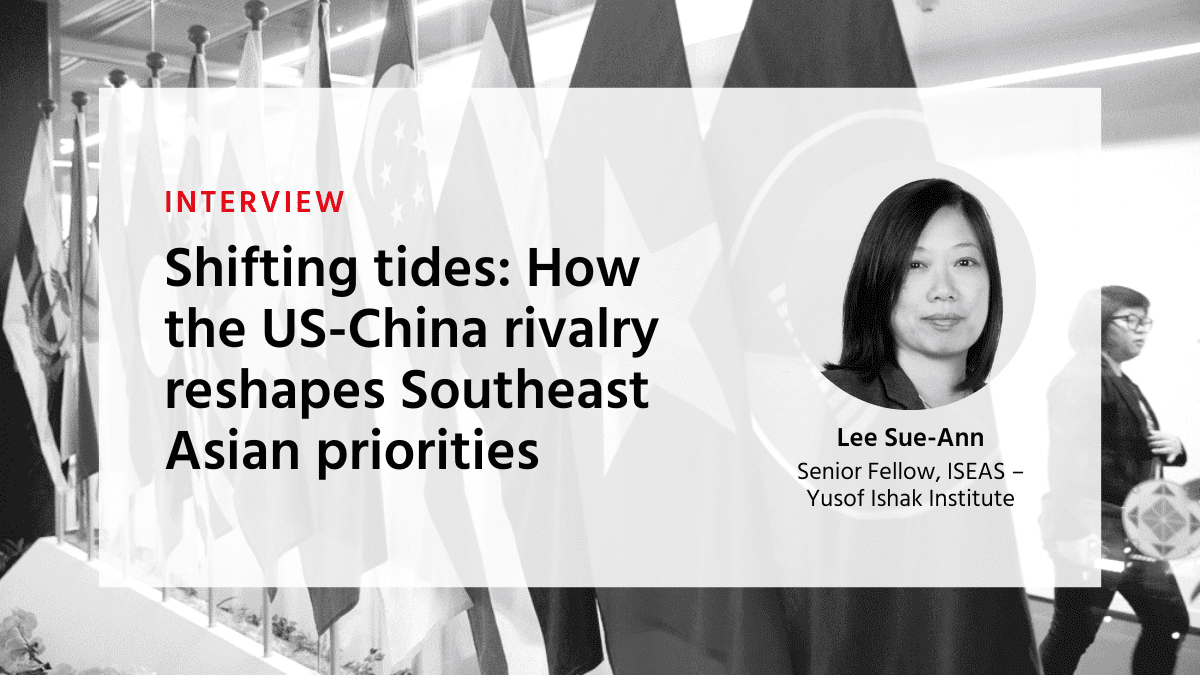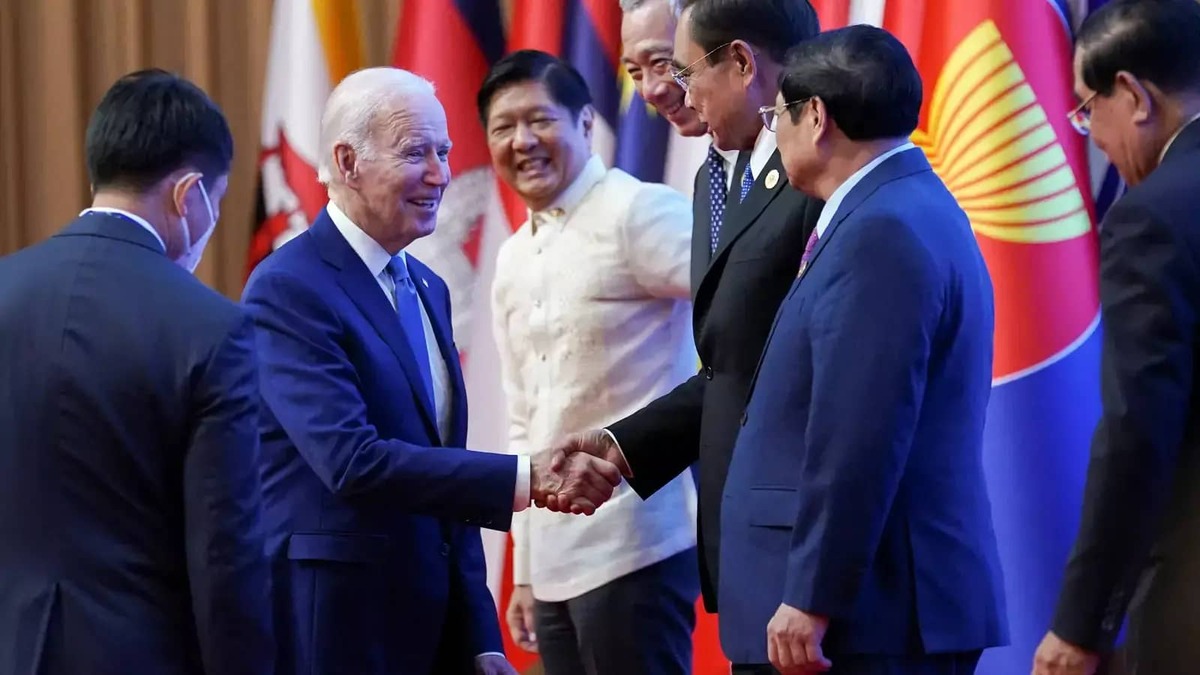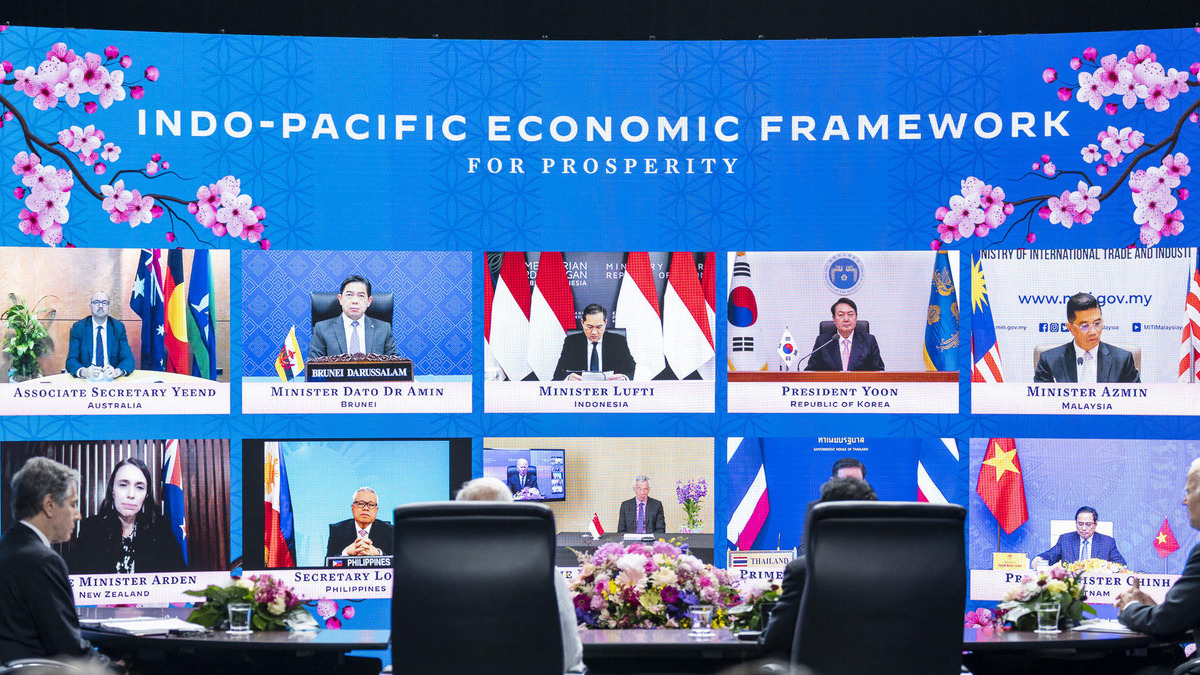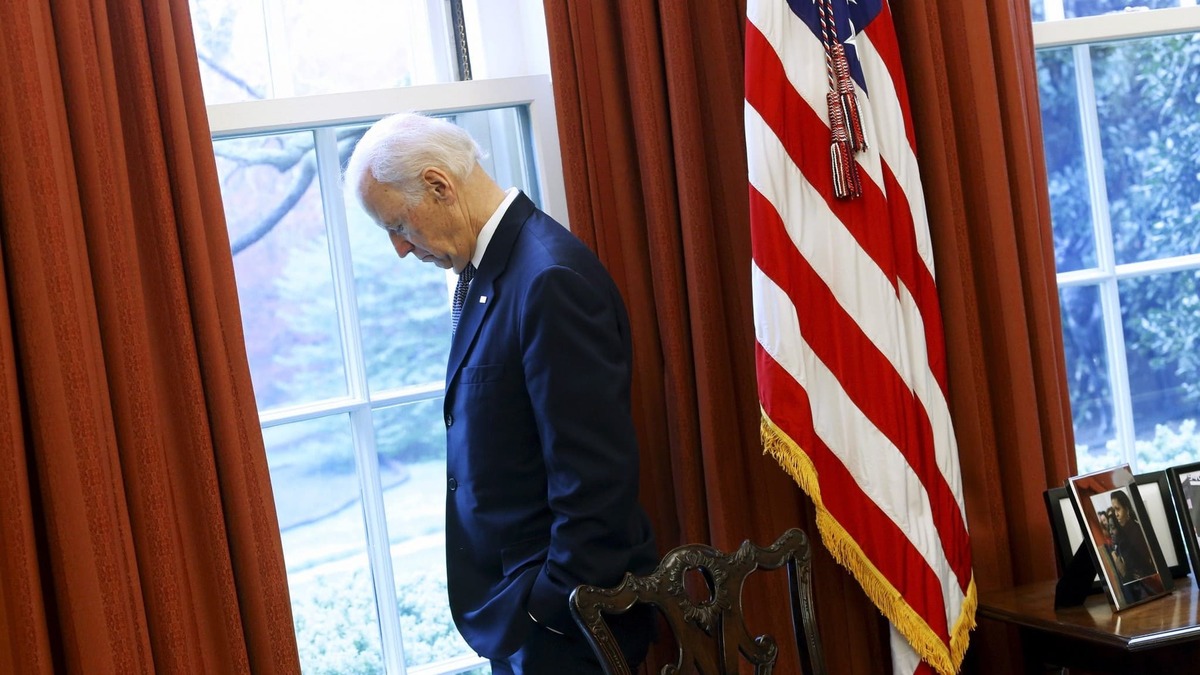US-China trade
Shifting tides: How the US-China rivalry reshapes Southeast Asian priorities
Published 07 November 2023
As Southeast Asia grapples with navigating the US-China contest, ISEAS-Yusok Ishak Institute Senior Fellow Lee Sue-Ann sat with the Association of Foreign Press Correspondents-USA for an interview based on an article she wrote for the Hinrich Foundation, urging a recalibration in the strategic dialogue between Washington and the region.
Over the past decade, the intensifying rivalry between the United States and China has had a profound impact on Southeast Asian leaders. This rivalry has transformed into a pivotal “Goldilocks dilemma” for the United States, which previously had Southeast Asian nations concerned about the prospect of a US-China G-2 model that might eclipse their interests. Today, the focus has shifted towards the rising temperature of this competition, where the ideological divide between the two superpowers has become increasingly intractable, injecting complexities and insecurities into the Southeast Asian region. These issues are exacerbated by the interwoven nature of Southeast Asia with global trade routes and supply chains.
Southeast Asian leaders are grappling with significant concerns related to the competition's ideological framing and securitization, making it increasingly challenging to separate issues and engage in constructive dialogue, says Lee Sue-Ann, a Senior Fellow and Coordinator of the Regional Strategic and Political Studies Programme, as well as an editor at Fulcrum, a publication of ISEAS – Yusof Ishak Institute, and an expert contributor to the Hinrich Foundation. The new strategic dialogue will have to center around how to recalibrate the strategic conversation between the United States and Southeast Asia in light of these evolving dynamics, Lee said in an editorial published by the Foundation and Fulcrum. This recalibration is essential because, as the United States acknowledges the need for a paradigm shift in its policies on international economics and protection of its middle class, Southeast Asian nations also grapple with similar constraints and use government interventions to support their economic development.
Amid a global rise in protectionist sentiments, it is crucial to evaluate how Southeast Asian countries will be affected by US trade policies and the spill-over of the US-China strategic competition into technology growth sectors. An important issue arises in terms of regulatory risks and the unpredictability of policy changes, potentially burdening Southeast Asian countries with stringent screening processes and regulatory uncertainties. This is exemplified in sectors like semiconductors and solar cells, where US trade policies could have significant implications.
The mismatch in perceptions between the US and Southeast Asia regarding the China threat has far-reaching consequences. While Southeast Asian countries are unlikely to take a uniform stance to align with US strategic policies on China, this divergence in perspective should not hinder cooperation and collaboration between Southeast Asia and the US, Lee says. An alternative American approach is needed, one that acknowledges the region's unique dynamics, independent foreign policy decision-making, and strategic autonomy.
The following interview has been condensed and edited for clarity.
Can you provide more context on the intensifying rivalry between the United States and China and its impact on Southeast Asian leaders?
This dynamic is best understood in terms of a Goldilocks dilemma for the United States. It’s hard to imagine that it was exactly a decade ago, during the Obama administration, when Southeast Asian countries were probably more concerned that the US would embrace Xi Jinping’s offer of a “New Type of Great Power Relations” and effectively adopt a G-2 model in dealing with world affairs. There was concern that the US would prioritise protecting US-China mutual interests and that Southeast Asia would be abandoned to deal with a more assertive and ambitious China without the US serving as an effective counterweight. As various polls and surveys have consistently shown, there has always been an enduring, even if often unsaid, desire to see the US remain strategically engaged in the region. The issue has always been about the reliability and consistency of the US’ commitment and engagement, given the multitude of international and domestic distractions the US has.
At the same time, the region’s leaders also don’t want the US’ strategic competition with China to get too hot—to the point of conflict or a hard decoupling. Needless to say, Southeast Asia being a vital node in maritime trade routes and also being enmeshed in global manufacturing supply chains would be profoundly impacted if that were to happen.
What are the key concerns that Southeast Asian leaders have expressed regarding this rivalry?
Today, we are closer to the “too hot” end of the spectrum. The concern is that the issues have become increasingly framed in irreconcilable ideological terms. Southeast Asian leaders accept that the U.S. and China would compete. But the concern is that the positions have hardened ideologically and the bilateral issues between the US and China have become conflated, over-securitised and difficult to untangle.
In the old days, it seemed easier to keep the issues separate. The Strategic and Economic Dialogue (S&ED), which was instituted in 2009 under the Obama administration, helped stabilise the bilateral relationship with a multitude of communication channels and meetings across various sectors, agencies and levels. These were halted during the Trump administration and it is only recently that there have been early signs of a thaw with the spate of bilateral visits by senior US officials to China. Let’s hope they keep these up and that productive outcomes will emerge from the talks.
You mention that it might be time for a shift in the strategic conversation between the United States and Southeast Asia. What are the main reasons for this need to shift gears, and what could a new conversation look like?
There is a need to shift gears because both sides are at risk of talking past each other, driven by their mutual inability or unwillingness to come to terms with the other party’s fundamental constraints and bottom lines. From the US perspective, it cannot fully accept the unwillingness of Southeast Asian countries to define the China threat in the same all-encompassing way the US currently seems to be defining the threat. For Southeast Asian countries, they cannot square the US’ fixation with democracy, human rights and values, and the perceived inconsistencies in the US’ actual policies and practices when realpolitik considerations kick in. Southeast Asians pointing out “whataboutisms” and hypocrisy in U.S. foreign policy behavior has been a constant feature of anti-US sentiment in the region.
Perhaps the new strategic conversation can be grounded on some honest recognition of the dynamics and constraints of realpolitik and a concrete focus on common issues of priority and concern. After all, it is clear that the US behaves, as all great powers do, according to hard realist calculations. This was demonstrated most recently by the upgrading of US ties with Vietnam to a Comprehensive Strategic Partnership and the push towards closer economic and defence cooperation—notwithstanding the fact that Vietnam has consistently abstained from condemning Russia’s invasion of Ukraine in the UN and continues to maintain close party-to-party ties with the Chinese Communist Party. However, the US and Vietnam share a mutual desire to keep Chinese assertiveness, especially in the South China Sea, in check.
We should also get rid of any pretence or expectations that the collective conversation between the US and Southeast Asian countries at the ASEAN level would be anything more than form over substance. Just a cursory comparison of the readouts from recent US-ASEAN and US-EU meetings would show the vast difference in the substance and depth of discussions on a range of issues. The strategic priorities and threat perceptions of the ten ASEAN member states (AMS) are clearly different, and there is a spectrum of views in terms of how each AMS would view the US and China’s roles in the region. ASEAN statements tend to be broad and bland—necessarily so, to reflect the lowest common denominator of consensus achievable. But we should not make the mistake of thinking that they reflect the sum total of the US-Southeast Asia relationship—as it is at the bilateral and mini-lateral levels where the real business with the US would take place.
In your analysis, you highlight some key messages from the United States, including a focus on the middle class and a more nuanced approach to international economics. How do these messages align with the interests and expectations of Southeast Asian countries?
I appreciate Jack Sullivan’s speech for its candour in acknowledging that globalisation and economic neoliberalism have resulted in an unequal division of the spoils of growth and that more needs to be done to protect the interests of ordinary workers. I wonder whether this can form a good starting basis for an honest conversation. Imagine a dialogue starting this way:
The US: Please hear me out here. I have some serious domestic political constraints that prevent me from giving you the lowered tariffs and market access concessions you want. We need to take care of our workers, preserve jobs etc.
Southeast Asian countries: Oh gee, we have similar constraints too! And like you, we have had to use some government intervention to give our people a leg up. But let’s negotiate … how much is too far and too much?
You discuss how the United States is likely to become more challenging to do business with in terms of free trade. Could you elaborate on the statistics regarding protectionist trade intervention policies and their implications for Southeast Asia?
The data shows that protectionist sentiments have generally been on the rise, ironically more so among the developed economies than the developing economies. They bear witness to the truth of what Jake Sullivan had encapsulated in his candid speech—that neoliberal “trickle down” economics has simply not worked. An Ipsos survey in 2021 strikingly showed that support for free trade was more prevalent among developing economies like Malaysia, South Africa, Peru and Brazil (above 60 percent) compared with the G7 countries where the percentage of respondents who believed free trade was beneficial for their economy was 50 percent or less. U.S. protectionism should be seen against this larger context.
Even so, the US-China strategic competition spilling over into new technology growth sectors will complicate things further. The key concern is regulatory risk and uncertainty over policy flip-flops. In early October, we saw the US giving concessions to South Korean chipmakers Samsung and SK Hynix to continue receiving certain US chipmaking tools at their Chinese plants. In addition, Taiwan’s TSMC was authorized to continue operating in Nanjing. This led to criticisms of policy inconsistency. And in a latest twist, the US Commerce Department announced on 17 October that it was further restricting China’s access to AI chips and chipmaking tools by expanding export controls to cover slightly less powerful chips than those under the previous rules, expanding the list of manufacturing equipment covered and blacklisting more Chinese chip companies.
For several Southeast Asian countries who are important nodes in the semiconductor value chain, this could mean the added burden of having to comply with more stringent screening processes and dealing with regulatory uncertainty. It was recently reported that some solar cells and modules exported from Southeast Asia could now face tariffs as high as 254 percent in June 2024, after the Commerce Department determined that Chinese or Chinese-linked companies operating in Cambodia, Malaysia, Thailand and Vietnam were avoiding the longstanding duties.
The analysis mentions a mismatch in perceptions between the U.S. and Southeast Asia regarding the China threat. Can you explain the implications of this mismatch and how it affects the region's approach to cooperation?
One implication is that the region will probably never be as unequivocal as the US would like in “calling out” China. But then, perhaps this is not an insurmountable issue. After all, as we have seen, not “calling out” Russia has not prevented the US from seeking cooperation with Vietnam.
What potential consequences could Southeast Asian countries face if they do not align with the U.S. bloc or if they are perceived as economically under China's sway? How can they maintain strategic agency and independence?
One consequence is that Southeast Asian countries could be excluded from sensitive discussions on cooperation and collaboration with the US in new emerging critical sectors. But I hope we are far from that point—as I argued in my article, it is important to break the false narrative that China dominates the region, because it does not. And perhaps Southeast Asian countries need to do more to demonstrate that they can and do take positions independent of Beijing and, for that matter, independent of the United States. Southeast Asian countries need to show that they can and do make their own strategic assessments and that they do pursue their own independent foreign policy and interests.
You highlight positive developments such as deepening economic cooperation between the United States and Southeast Asia, especially in technology-related sectors. What are some specific opportunities and challenges associated with these developments?
To the extent that the individual Southeast Asian countries can be recognised for their strategic value in their own right, and not be seen through a “with-us-or against-us” prism vis-à-vis China, there are numerous opportunities for US companies to diversify and fortify their supply chains in various sectors by investing and trading more in Southeast Asia. And in so doing, this will bring strategic dividends in giving the region more options.
***
This article was first published by ForeignPress.org.
© The Hinrich Foundation. See our website Terms and conditions for our copyright and reprint policy. All statements of fact and the views, conclusions and recommendations expressed in this publication are the sole responsibility of the author(s).






